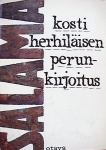(Urban space) Cheonggyecheon reopening reconsidered
 The reopening of Ch'ônggyech'ôn (Cheonggyecheon) river flowing through downtown Seoul first looked like a wonderful idea and got a lot of praise; the noise raised by the street peddlers driven away seemed to settle soon and their position did not get much support. Just like the covering of Cheonggyecheon in the 60s was associated with the ideas of development and modernization at the time, the reopening project has to do with the current ideas of modernity of development, this time not traffic and flow of goods and people but by leisure, quality of life, "green values" etc. After the Korean war the Cheonggyecheon became a site of squatter settlement, with 2-3 storey shacks built on poles on both sides. It was definitely not a pretty sight except for those who want to glorify poverty. They are not missed, but it's the other links with the history of Seoul and Korea that have given meaning to the new criticisms: Chosôn era trade, proximity to Tongdaemun market, Chosôn era architecture and construction landmarks. The reopening of Ch'ônggyech'ôn (Cheonggyecheon) river flowing through downtown Seoul first looked like a wonderful idea and got a lot of praise; the noise raised by the street peddlers driven away seemed to settle soon and their position did not get much support. Just like the covering of Cheonggyecheon in the 60s was associated with the ideas of development and modernization at the time, the reopening project has to do with the current ideas of modernity of development, this time not traffic and flow of goods and people but by leisure, quality of life, "green values" etc. After the Korean war the Cheonggyecheon became a site of squatter settlement, with 2-3 storey shacks built on poles on both sides. It was definitely not a pretty sight except for those who want to glorify poverty. They are not missed, but it's the other links with the history of Seoul and Korea that have given meaning to the new criticisms: Chosôn era trade, proximity to Tongdaemun market, Chosôn era architecture and construction landmarks.With the discovery of bigger number of Chosôn (Joseon) era remnants than expected the whole project is being questioned more than ever. Lately especially Hankyoreh has used a lot of energy in showing what's going wrong with the Cheonggyecheon project, particularly in the way the historical considerations are being ignored. The main target of criticism is mayor Yi Myông-bak (Lee Myung-bak or whatever), who campaigned with the project as a mayoral candidate, and who is now being accused of bulldozing the project to get it done during his term. Kaebal tokchae, "development authoritarianism" (or dictatorship) has been brought out to describe the manner in which the project is being promoted. Interestingly (am I using that word too much?) it's been Hankyoreh that first suggested the idea of bringing Cheonggyecheon back to life (toesalligi). Here's a column by the chief of the editorial department (p'yônjippu kukchang), in which he brings forth for example the writer Pak Kyông-ri's change of mind; at first she supported the project, but now that she has realized that the history is not being revitalized (?) and the place not being made "into a place where people can live a humane life", she regrets her support. An older article (from Feb 20) of the discovery of historical remains like bridge structures and memorial stones  The latest development is the filing of a complaint (kobal) against Yi Myông-bak by the "Cheonggyecheon Citizen's Council (청계천복원시민위원회) for damaging cultural remains. (For many more pieces on the Cheonggyecheon issue, see the articles listed below the linked articles.) The latest development is the filing of a complaint (kobal) against Yi Myông-bak by the "Cheonggyecheon Citizen's Council (청계천복원시민위원회) for damaging cultural remains. (For many more pieces on the Cheonggyecheon issue, see the articles listed below the linked articles.)The Seoul Metropolitan goverment's Cheonggyecheon revival/reopening/construction homepage. And with the same google I found this, a Cheonggyecheon photography site by someone who has taken the trouble and gone recording the Cheonggyecheon scenery that was going to vanish. Fine pictures! My initial reaction: are there no legally defined guidelines for the preservation of cultural relics unearthed during construction works, which would restrict the construction? But then, should I be surprised that none is found for this? Oh well, the Cheonggyecheon Citizens' Committee has filed the complain agains mayor Pak using the law for preservation of cultural relics (문화재보호법), so there is some. The question is now the interpretation and enforcement of the law... The 5000 years of Korean history in Seoul? Doesn't seem to be even 5000 weeks. Update: Seoul authorities have decided to halt the construction work at the sites where the discoveries have been made, as Cultural Properties Administration (?, 문화재청) gave its position that no further works should be done until the decision on the management of the excavated properties (Hankyoreh). The article lists the legal recourses available for protecting the excavated cultural properties in cases like this. (But I'm too busy to start translating.) Categories at del.icio.us/hunjang: cities ∙ Koreanpolitics ∙ contemp.history |

